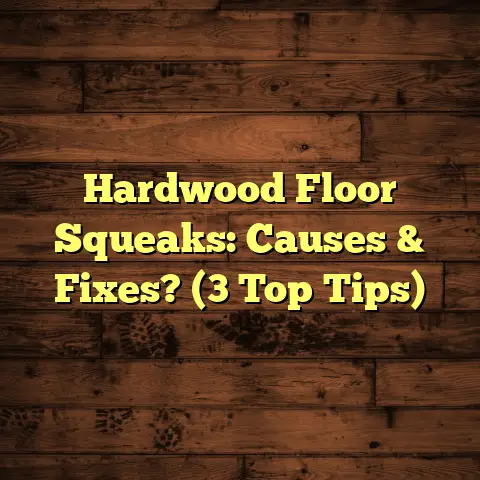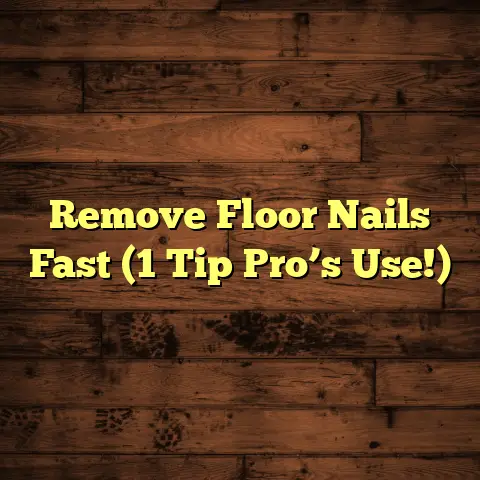What Size Staple For 3/4 Hardwood Floor? (Explained)
When it comes to installing a 3/4″ hardwood floor, one question that often pops up is: What size staple should I use? This seemingly simple question can have a significant impact on the quality of the installation and the long-term durability of the floor.
I’ve had my fair share of flooring projects, and I can tell you that getting the right staple size can make all the difference in achieving a flawless finish.
Let me share my insights and experiences on this topic in detail.
Why Staple Size Matters
Choosing the correct size of staples is critical for ensuring a strong and durable installation.
If the staples are too short, they won’t hold the boards securely, leading to potential movement and squeaks over time.
On the other hand, if they’re too long, they may penetrate too deep and damage any underlying layers or even the subfloor.
My Experience with Staple Sizes
In my early days as a flooring contractor, I learned this lesson the hard way.
I was working on a residential project in a cozy neighborhood in Ohio, installing 3/4″ oak flooring.
I opted for a staple size that I thought would be sufficient—maybe a 1″ staple—but as I progressed, I realized it wasn’t quite right.
The staples didn’t hold the boards as firmly as I wanted, and I noticed slight movement in some areas.
After that experience, I researched more about staple sizes and came across some useful guidelines.
For 3/4″ hardwood floors, a staple length of 1.25″ to 1.5″ is generally recommended.
This length allows for the staple to penetrate adequately into both the hardwood and the subfloor without risking damage.
Understanding Hardwood Flooring Dimensions
Before we dive deeper into staple sizes, it’s important to understand some dimensions related to hardwood flooring.
Hardwood flooring comes in various thicknesses, widths, and lengths.
The most common thickness for solid hardwood flooring is 3/4″.
This thickness provides durability and stability, making it suitable for both residential and commercial spaces.
Thickness and Stability
The 3/4″ thickness is often chosen because it offers a solid feel underfoot and can be sanded and refinished multiple times throughout its lifespan.
This is crucial for homeowners who want their floors to last for decades.
In my experience, this thickness also allows for better sound insulation and warmth compared to thinner options.
Width Options
Hardwood flooring comes in different widths as well—from narrow strips to wide planks.
The width can affect the overall appearance of the room.
For example, wider planks can give a more modern look but may also expand and contract more with humidity changes.
Choosing the right width depends on personal style preferences and the specific room’s dimensions.
Choosing the Right Staple Size
Factors to Consider
- Type of Subfloor: Is it plywood or concrete?
If you’re installing over plywood, you want to ensure the staples reach deep enough to secure the hardwood without piercing through.
For concrete, you might use an adhesive in conjunction with staples. - Humidity and Temperature: Wood expands and contracts with changes in humidity and temperature.
This means your staples should be able to accommodate some movement without losing their grip. - Manufacturer Recommendations: Always check the hardwood flooring manufacturer’s guidelines.
They often provide specific recommendations for staple sizes based on their products.
Personal Anecdote
During a recent project in a beautiful home in Chicago, I had a client who was adamant about using shorter staples due to concerns about damage to the subfloor.
I decided to compromise by using 1.25″ staples, which provided a good balance between security and safety.
They were happy with the outcome, and I didn’t have any issues with board movement afterward.
Installation Techniques
Stapling Process
When installing hardwood floors with staples, here’s how I approach it:
- Preparation: Ensure that the subfloor is clean and dry.
If you’re working with plywood, check for any loose or damaged areas. - Lay Out Your Boards: Before stapling, I like to lay out a few boards to visualize how they’ll fit together.
This helps me plan where to place staples for maximum support. - Using a Flooring Stapler: A pneumatic flooring stapler is my go-to tool for this job.
It drives staples quickly and consistently, making the process much smoother. - Spacing: Typically, I place staples every 6 to 8 inches along the board’s length.
This spacing ensures that each board is securely fastened while allowing for some expansion.
Tools Required for Installation
To ensure a smooth installation process, having the right tools is essential.
Here’s a list of tools I typically use:
- Pneumatic Flooring Stapler: This tool allows for rapid stapling without excessive effort.
- Compressor: A compressor is needed to power the pneumatic stapler.
- Measuring Tape: Accurate measurements are crucial in flooring installation.
- Chalk Line: This helps create straight lines for alignment.
- Pull Bar and Tapping Block: These tools help snugly fit boards together.
- Safety Gear: Always wear safety glasses and gloves while working.
Challenges Faced
Every project comes with its challenges.
Once, while installing in a high-humidity area, I noticed that some boards were expanding more than anticipated after installation.
This created tension on the staples.
Since then, I’ve learned to leave a little extra room at the ends of my boards to accommodate movement.
Dealing with Uneven Subfloors
One common challenge I’ve faced is dealing with uneven subfloors.
An uneven surface can lead to difficulties when stapling down hardwood floors, resulting in gaps or raised areas once installed.
To combat this issue, I often use leveling compounds or additional plywood layers to create a smoother surface before installation.
It’s an extra step but pays off in ensuring a professional finish.
Client Concerns
Another challenge can arise from client concerns about noise levels or potential squeaking after installation.
To address this, I always explain how proper stapling techniques can minimize these issues while ensuring they understand the importance of acclimating their hardwood before installation.
Cost Estimation with FloorTally
When it comes to estimating costs for materials like staples and other supplies, I often rely on FloorTally.
This tool allows me to input various factors like square footage and material types to provide accurate estimates.
I remember one project where I had to order staples specifically for a 3/4″ installation.
Using FloorTally helped me calculate exactly how many staples I would need based on my layout, saving me time and ensuring I didn’t overbuy or underbuy.
Breakdown of Costs
Using FloorTally, here’s how I typically break down costs for an installation:
- Materials: This includes hardwood flooring, staples, underlayment (if needed), and adhesive (if applicable).
- Labor: Depending on the complexity of the project, labor costs can vary significantly.
- Tools: If you don’t own all necessary tools, there may be rental costs involved.
- Miscellaneous Costs: Always factor in potential unexpected expenses such as additional leveling materials or repairs needed on the subfloor.
In one instance, I was able to identify that using less expensive staples didn’t compromise quality but saved my client a significant amount of money overall because they still performed adequately.
Maintenance Tips
After installation, proper maintenance of your hardwood floor is essential:
- Regular Cleaning: Sweep or vacuum regularly to prevent dirt from scratching the surface.
- Humidity Control: Keep an eye on humidity levels in your home—ideally between 30% and 50%.
- Use Rugs: Placing rugs in high-traffic areas can help reduce wear on your hardwood.
- Refinishing: Depending on foot traffic and wear patterns, consider refinishing your hardwood floors every few years to restore their beauty.
Troubleshooting Common Issues
Squeaking Floors
Squeaking is one of those annoying issues that can arise after installation.
If you notice squeaks, it could be due to loose staples or boards not properly secured.
To troubleshoot this:
- Identify where the squeak is coming from.
- Use a screw or two to tighten boards back into place if they’ve shifted.
- If necessary, add additional staples in areas that feel loose.
Gaps Between Boards
To address gaps:
- Monitor humidity levels regularly.
- Consider using wood filler or touch-up stains if gaps are minimal.
- Acclimate wood properly before installation to help minimize future movement.
Comparing Staple Options
You might wonder if there are alternatives to staples for securing hardwood floors.
Let’s briefly compare:
- Nails: Traditional but can be tricky if you’re not careful; they require more skill.
- Glue: Great for installations over concrete but can be messier and requires precise application.
- Staples: Convenient for DIY projects—my personal favorite for ease of use and effectiveness.
In my experience, staples tend to be more reliable for securing 3/4″ hardwood floors compared to nails or glue.
Long-term Considerations
When weighing your options for fastening methods, consider long-term maintainability as well.
Staples allow for easier removal if you decide to refinish or replace flooring later on compared to glued-down methods.
Real-Life Case Studies
Case Study 1: Residential Installation
I once worked on a residential project where the homeowner wanted a rustic look with wide plank oak flooring installed over plywood subfloors.
We used 1.5” staples throughout for optimal holding power due to their concerns about potential movement as seasons changed.
After completion, they expressed how pleased they were with both appearance and performance—there were no squeaks or gaps evident even years later!
Case Study 2: Commercial Space
In another instance, we installed flooring in an upscale restaurant’s dining area using engineered hardwood planks over concrete subfloors.
We opted for glue-down methods instead of staples because of noise considerations impacting customer experience.
This approach required meticulous application but ultimately provided fantastic results without any issues down the line regarding board movement or noise levels—a win-win situation!
Conclusion
So, what’s the takeaway?
For 3/4″ hardwood floor installations, using 1.25″ to 1.5″ staples will help ensure you achieve a secure and durable result.
Be mindful of your subfloor type, environmental conditions, and always refer to manufacturer guidelines.
Remember my story about client concerns?
Balancing client preferences while ensuring structural integrity is key in our line of work.
And don’t forget about tools like FloorTally—they can simplify your cost estimations tremendously.
By keeping these tips in mind, you’ll set yourself up for success in your next hardwood flooring project!
What experiences have you had with staple sizes?





